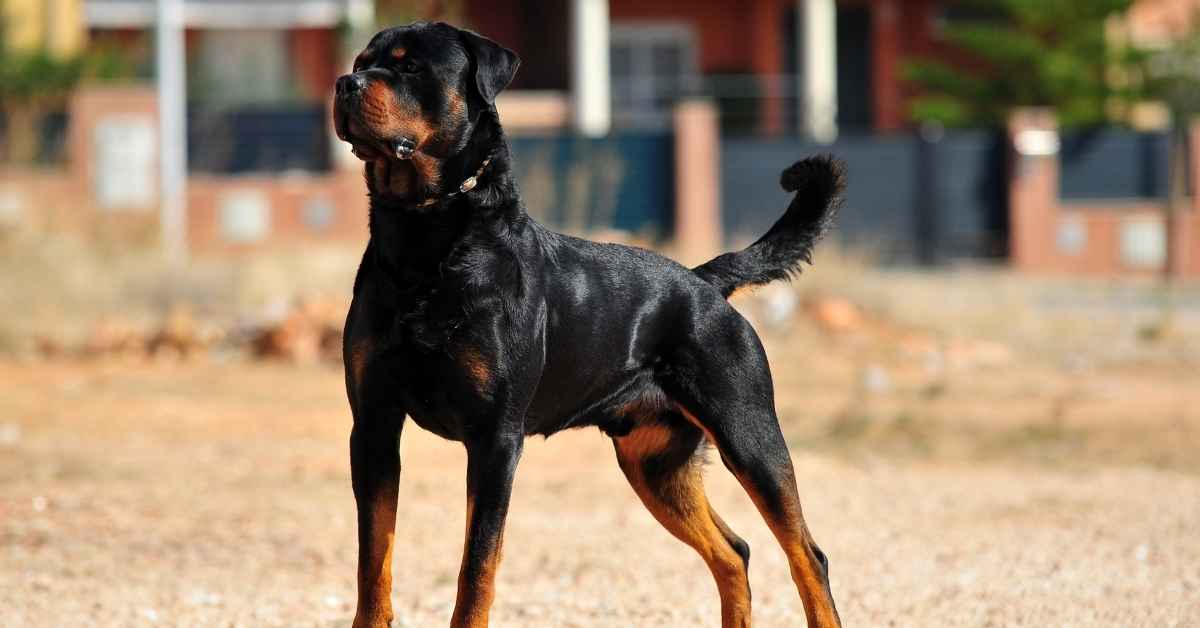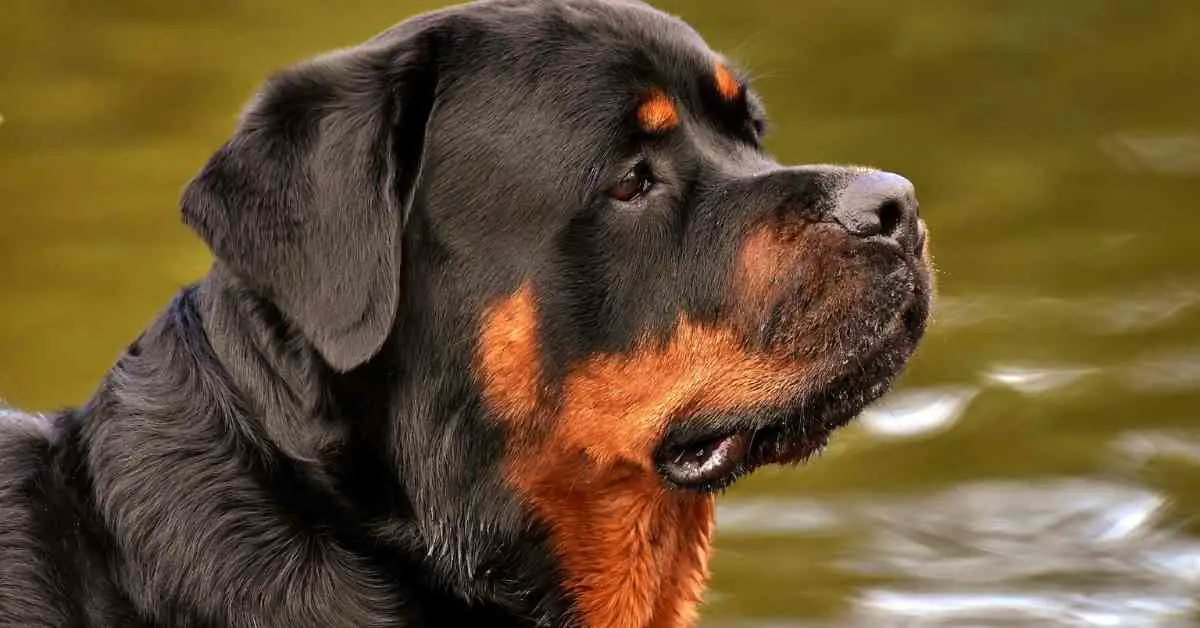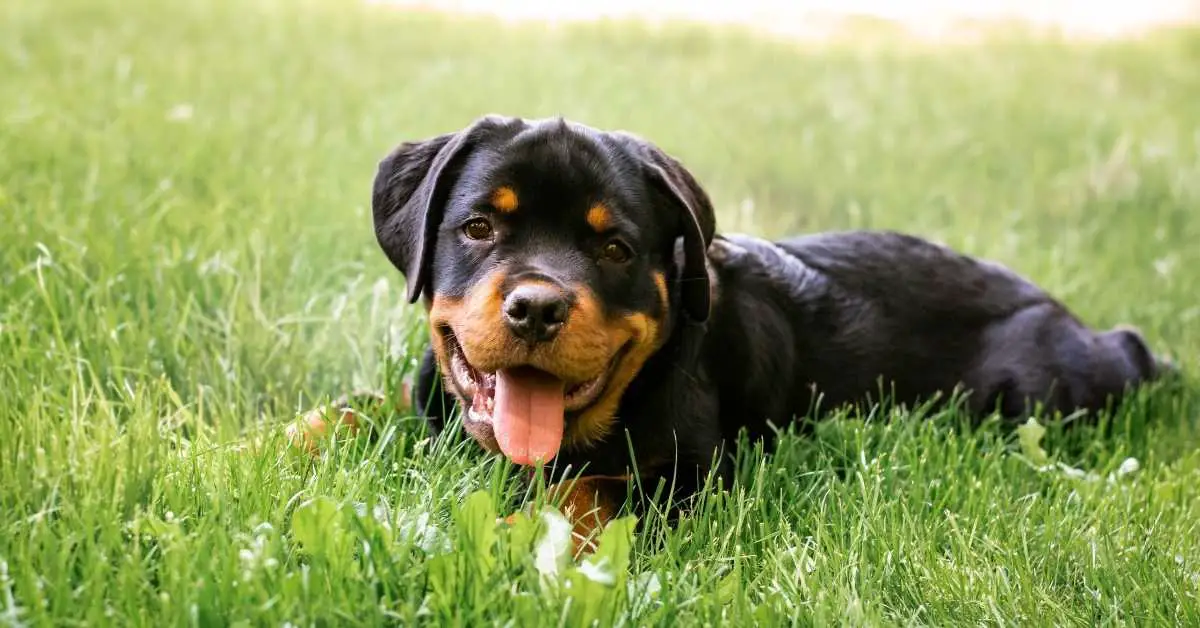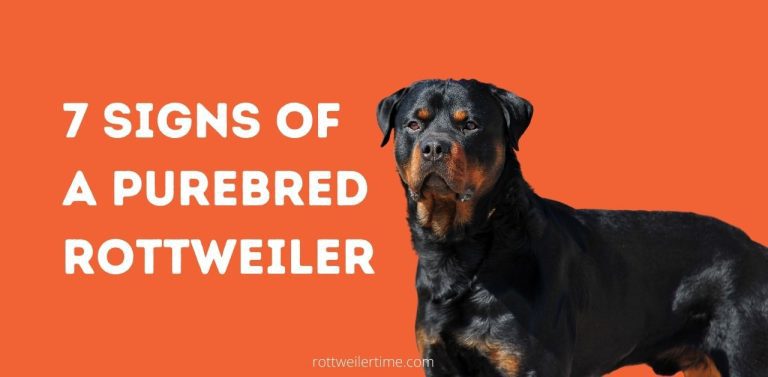Every breeder wants their puppies to be purebred, and most have very specific standards about what counts as purebred. A dog that meets those standards can often find an easier path to breeding than one that doesn’t.
However, there are also less-than-reputable breeders who will sell you any mutt, as long as you’re willing to pay enough money.
So how do you know if your Rottweiler puppy really is purebred?
Here are 7 signs to tell if your Rottweiler puppy is the real deal or not!
Contents
- 1 1. Check out the Rottweiler Ears
- 2 2. Rottweiler’s general appearance
- 3 2. Head of a Purebred Rottweiler
- 4 3. Rottweiler’s Muzzle
- 5 4. Purebred Rottweiler’s Tail
- 6 5. Forequarters
- 7 6. Coat texture
- 8 7. Watch out for a characteristic smile
- 9 How to get a Pure Breed Rottweiler Puppy
- 10 Inquire about temperament
- 11 Examine the body structure and proportions
- 12 Find a reputable breeder
- 13 Keep in mind physical appearances can change as they grow up
- 14 Ask about their lineage or ancestors
- 15 Ask about registration papers
- 16 Ask how long they have been breeding dogs
- 17 Checkout the Rottweiler Breed Standard
1. Check out the Rottweiler Ears
One of the easiest ways to tell if your puppy is purebred is by checking out his ears. A purebred puppy’s ears are in a distinct V shape, with rounded tips.
Some people make a distinction between those two characteristics: If a puppy has V-shaped ears with rounded tips, he’s considered purebred.
But all puppies have some variance in their ear shapes, so it can be difficult at times to determine exactly what kind of dog you’re getting. Only about 75 percent of all Rottweilers have typical V-shaped ears with rounded tips.
The other 25 percent have drop ears that hang lower than normal and don’t follow a V pattern. The American Kennel Club does not recognize drop ears as a breed trait for Rottweilers; however, many breeders will still sell these dogs as purebreds.
Be sure to ask questions about how your puppy was bred before agreeing to buy him from someone who claims he’s 100 percent pure.
Read Also: The Care for Your Rottweiler Ears | The Complete Guide
2. Rottweiler’s general appearance
Unlike some of its cousin breeds, a typical Rottweiler should be square in appearance; he shouldn’t look narrow or long like a greyhound.
He also shouldn’t have legs that are too short for his body, nor should he have giant paws or tiny feet.
The color should be Always black with rust to mahogany markings, all Rottweilers should possess what breeders call black masking—the dark coloring around their eyes and muzzle.
The overall head shape may vary slightly depending on your dog’s gender—but males will generally have broader heads than females do.
In general, though, your pup should have a broad forehead with large ears set high up toward the top of his skull; his face should be wide with a pronounced stop (where it meets his muzzle); a strong jawline; small eyes with dark rims around them; and an underbite/undershot jawline that can sometimes cause teeth to overlap when they close together.

2. Head of a Purebred Rottweiler
A purebred Rottweiler will have a large, broad head that has straight lines running from its eyes to its nostrils. These dogs will also have an even bite and dark round eyes.
For example, your pup’s nose should be black in color with no hints of pink at all. If you don’t know whether or not your pup is pure, bring him or her over for a checkup by one of our veterinarians; they can make sure that everything—and everyone—is healthy!
In addition to checking out their heads, there are several other ways to tell if your pooch is purebred. First, look at his eyes: do they appear bright and expressive?

3. Rottweiler’s Muzzle
One of the first ways that you can tell if your puppy is purebred is by looking at his muzzle. A purebred dog will have a muzzle that tapers down from its eyes toward its nose and mouth. The taper should be quite obvious in most cases.
Many owners are surprised at how quickly their pup’s muzzle begins to change shape and size over time, especially in large dogs like pit bulls and rottweilers.
However, even a slight difference between two puppies bred from distinct bloodlines will usually be noticeable by 3 or 4 months of age.
4. Purebred Rottweiler’s Tail
Some purebred Rottweilers have tails that are naturally short, while other purebreds have tails that are docked by a vet.
Short and docked tails are preferred in many competitive dog shows. If you’re looking for a purebred, you’ll want to pay attention to your puppy’s tail at birth; these tails may change as they grow older.
You can tell whether or not your puppy has a naturally short tail by gently wiggling it back and forth; natural short tails will move easily. If it feels stiff or painful, then your pup has had his/her tail docked. It’s important to note that docking of any kind is illegal in some states—you should check with local animal control before making any assumptions about what constitutes purebred-ness for dogs in your area.
Checkout Guide On: Rottweiler Tail: The Debate Between Natural Vs Docked Tail

5. Forequarters
A dog’s shoulders should be slightly longer than its chest and ribcage, but shorter than its spine. The distance between the withers – where a dog’s back begins – to the base of its tail should also be about one-third of the dog’s height at the withers.
When it comes to his front paws, they should have strong bones and never look too closely set to each other or they will appear overworked.
Finally, his feet need firm yet flexible pads with an arch so he can stand still while doing whatever it is he needs to do.
6. Coat texture
A purebred Rottweiler puppy will have a coarse and dense double coat. It will be straight, thick, and lie flat against your puppy’s body.
The soft undercoat will be covered by longer guard hairs that are about 1-1.5 inches long. If you can see a black or brown base color beneath the hairs of your pup’s fur, there’s a good chance it could be considered purebred.
The coat of the Rottweiler varies greatly depending on its environment – whether it be hot or cold. During warmer months, there will not be much fur at all around the neck and thighs – where it might grow too long for comfort otherwise. But during colder seasons, you can expect to see plenty of fur coating these regions instead.
7. Watch out for a characteristic smile
Purebred Rottweilers often show a characteristic smile as pups. While it’s not specific to Rotties, you can use it as an indicator that you have a purebred pup on your hands!
If your puppy lacks a smile but does appear happy and healthy otherwise, it might not be purebred. If in doubt, consult a vet or animal shelter representative for advice.

How to get a Pure Breed Rottweiler Puppy
Inquire about temperament
In addition to finding out about a breeder’s knowledge of bloodlines, ask questions about temperament. Getting answers from your breeder will give you a good idea of what kind of puppy you should expect.
Of course, it’s impossible for a breeder to guarantee their puppies won’t grow up to have problems – no one can predict how an individual dog will develop or react in certain situations.
But if a breeder seems completely honest and forthcoming with information and references, there’s a chance they’re also keeping quality lines that produce solid dogs.
Examine the body structure and proportions
The first thing you want to do when checking out a Rottie pup takes a look at how he’s put together. It’s not quite as obvious as it may be with other breeds (and if you don’t know what those other breeds look like, that’s OK) but once you’re attuned to it, there are plenty of signs your puppy has true Rottie lineage.
The main things to check are the size and shape of the head, length of back and tail, size and shape of paws, length of the nose, and ear placement.
These traits will change as your puppy ages—this is just what they should look like at birth!
Find a reputable breeder
Finding a reputable breeder doesn’t have to be difficult. Some good places to start looking include local breed-specific clubs, dog parks, and rescue organizations.
Breeders can also be found at local trade shows, but make sure you ask for references and contact those people before visiting a breeder’s home or farm.
It’s easy for breeders (even honest ones) to mislead potential buyers. A good rule of thumb is that it shouldn’t cost more than $4,000 in total for an adorable ball of fluff that’ll grow into your best friend over many years.
Anywhere beyond that will likely result in an expensive pet store puppy with behavioral problems or simply too much money spent on health issues down the road.
Related Guide on: How To Find The Right Rottweiler Breeder – Best Tips
Keep in mind physical appearances can change as they grow up
The first thing you want to do is make sure your puppy has a short, compact body that’s square in appearance. The head should be large and broad with a noticeable stop between it and its muzzle.
The eyes should be dark and wide-set, while the ears should be small but v-shaped with rounded tips.
Ask about their lineage or ancestors
If you’re interested in buying a purebred puppy, it’s worth asking about its lineage. Many breeders are happy to talk about their dogs and can share pictures of their parents or other puppies they’ve raised.
Remember that reputable breeders are never going to sell a sick dog—and that includes more than just physical health: Good breeders will also take pride in nurturing emotionally healthy animals and will want to be sure that buyers recognize any potential issues with traits from either side of your pup’s family tree. Good breeding leads to good dogs.
Ask about registration papers
You can never be 100% sure a dog is purebred, but it’s still important to know about registration papers. If you’re buying a puppy, ask for information about its parents and their registration papers.
Documents like these can help prove that your new dog has pure bloodlines. If you’re looking at adult dogs, contact their owners and ask for registration documents.
In some cases, these records might even confirm how much training a dog has had. While individual dogs might not be perfect, they are an important part of breeding strategies by dedicated breeders who want to preserve a certain type of animal and line.
Ask how long they have been breeding dogs
While you might think it’s obvious that they have been breeding dogs for years, in some cases, people start breeding or selling dogs after seeing a quick buck.
You should only trust someone who has been in business for at least five years and can show you records of their puppy sales.
Each litter should have paperwork with each dog’s lineage and registration number. This ensures that puppies come from good stock; there’s no way to verify parentage if not properly registered with a kennel club.
Not all kennel clubs are equal, however—you want to make sure your breeder registers their puppies with a reputable one, such as AKC (American Kennel Club).
To be able to register puppies from an AKC litter, both parents must be registered.
Checkout the Rottweiler Breed Standard
A purebred rottweiler can be recognized by what they look like and that’s why it’s important to make sure your puppy actually has papers.
The American Kennel Club (AKC) is an internationally recognized organization that maintains pedigrees for specific breeds of dogs. You should also research and check with other organizations on whether or not your dog is a purebred Rottie.
They include The United Kennel Club, The International Rottweiler Federation, Inc., The Foundation Stock Service, and many more. So what are you waiting for? Start checking into those documents!
Download Below the Official Rottweilwe Breed Standards By Akc
https://images.akc.org/pdf/breeds/standards/Rottweiler.pdf
Meet the Author Mehmood Shah,
As an owner of Rottweiler for 10 years, I motivate and encourage people about this lovely breed.
We’re dedicated to providing you the detailed researched articles about Rottweiler, with an emphasis on Rottweiler Health, Training, and Exercises.
I started my journey with Rottweiler Time in 2021 and it has come a long way from its beginnings.
Thanks for Your Support.


